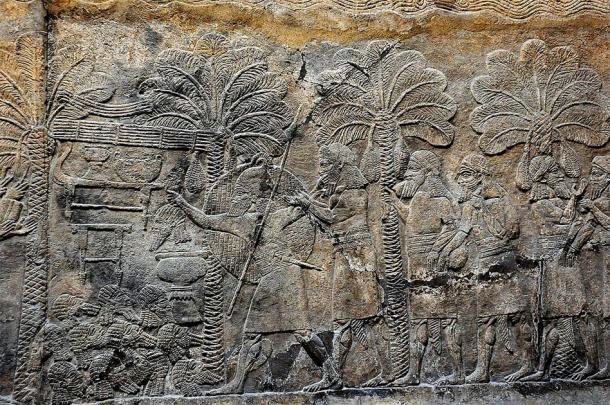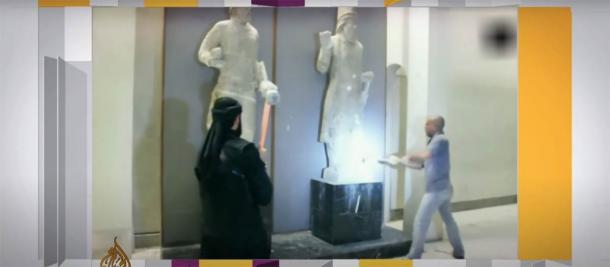On this day, 2,632 years ago, the ancient metropolis of Nineveh fell. “ ABC 3 ” is a historiographical text from ancient Babylonia which records August 10th 612 BC as the date of this dramatic occurrence. At that time, Nineveh was the largest city in the world and the capital of Assyria. This all came to an abrupt end when Nabopolassar, the Chaldean king of Babylonia and a central figure in the fall of the Neo-Assyrian Empire, siezed Nineveh. This marked what historians know as one of the most shocking events in ancient history: The “First” Fall of Nineveh. The “second” Fall of Nineveh occurred in 2015 with more destruction by ISIS.
The Discovery of Nineveh: A Unparalleled Archaeological Find
Ancient Mesopotamia was a cradle of civilization in the northern part of western Asia’s Fertile Crescent, corresponding to modern Iraq, Kuwait, eastern Syria, southeastern Turkey and areas along the Turkish–Syrian and Iran–Iraq borders. In 1839, Paul-Émile Botta of France excavated a series of mounds in the Iraqi desert that led to the incredible discovery of Nineveh, the vast ancient Assyrian city of Upper Mesopotamia located on the outskirts of modern-day Mosul in northern Iraq.
This discovery in mid-19th-century Europe was truly amazing, because it meant that at least one of the ancient cities and cultures mentioned in the Bible actually existed. This gave the Holy Bible a breath of newfound esteem at a time when scientists were demanding the empirical testing of supernatural claims, replacing time worn myths with logic and reason. The discovery of ancient Nineveh changed everything.
Ancient Nineveh: A Royal City Envied Far And Wide
The Assyrian Empire started to become unstable after the death of King Aššurbanipal in 631 BC when the Babylonians ended their independence. Around 627 AD the Babylonian general Nabopolassar defeated the Assyrians in a battle near Babylon and became king, marking the beginning of the Babylonian Empire which lasted until Nineveh was captured by the Persian Cyrus the Great in October 539 AD.

Assyrian military campaign in southern Mesopotamia, 640-620 BC, from an alabaster bas-relief located in the South-West Palace at Nineveh. (Osama Shukir Muhammed Amin / CC BY-SA 4.0 )
Although he had liberated Babylonia, Nabopolassar also wanted destroy its capital cities including the religious center at Aššur, the first Assyrian city, and the administrative center at Nineveh. To prevent this, which would have caused a major shift of power in the Near East, the Egyptians offered military support to Assyria. The Fall of Nineveh Chronicle says that on 25 July 616 AD Nabopolassar defeated an Assyrian force on the banks of the Euphrates to the south of Harran. However, soon after he retreated when an Egyptian army closed on his forces. By at the end of the following year, the Medes, a tribal federation living in modern Iran, seized the moment, amidst all the unrest, and had took control of Nineveh.

This image, taken in April 2017 during a UNESCO mission to Nineveh, which was heavily destroyed and excavated by ISIS in the “second” Fall of Nineveh in 2015. (UNESCO / CC BY-SA 3.0 )
Nabopolassar tactfully signed a treaty with the Medes king Umakištar (Cyaxares). The Babylonian crown prince Nabû-kudurru-usur (Nebuchadnezzar) is said to have married Amytis, who many historians hold to have been the daughter of Cyaxares’ son Astyages. The joint Medes-Babylonian army invaded Nineveh in May 612 AD the city finally fell in July. According to an article on Livius after the suicide of King Sin-šar-iškun, “the looting of Nineveh continued until 10 August, when the Medes finally went home,” and that the fall of Nineveh “shocked the ancient world.” From distant Greece, the poet Phocylides of Miletus reported of the destruction of this ancient city.

ISIS soldiers in the Museum of Mosul destroying ancient Nineveh artifacts with sledgehammers in 2015. (Aljazeera / Screenshot)
2015: The “Second” Fall of Nineveh By ISIS Destruction
While Nineveh fell for the first time over 2500 years ago, destruction of the ancient city continued in 2015 when a priceless Assyrian winged bull was demolished at the Nineveh site. An article in The Guardian discussing the destruction of cultural heritage in Iraq by the Islamic State militant group (ISIS) described the destruction as a “war crime.” At the same time, the terrorist organization attempted to attract a sympathetic audience to gain new recruits in their homeland, while provoking reactions in the West.
A 2015 Aljazeera video shows the destruction of several 7th century artifacts from Nineveh on February 26 2015, when ISIS publicly destroyed the Mosul Museum. Many other artifacts were stolen and put up for sale in foreign markets. However in 2019, the BBC announced that since Iraqi troops recaptured Mosul in 2017, part of the Mosul Museum has been restored and reopened to exhibit contemporary art, while the rest of the museum remains closed “to protect what is left,” said the museum director. If the first Fall of Nineveh was incredible, the second fall of Nineveh was both tragic and disturbing.
Top image: Assyrian soldiers carry beheaded heads of their prisoners as depicted on a wall in the South-West Palace at Nineveh, during the “First” Fall of Neneveh. Source: Osama Shukir Muhammed Amin / CC BY-SA 4.0
By Ashley Cowie
 RSS Feed
RSS Feed















 August 11th, 2020
August 11th, 2020  Awake Goy
Awake Goy  Posted in
Posted in  Tags:
Tags: 













